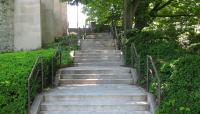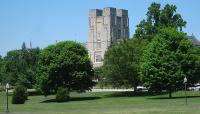Landscape Information
Virginia Tech’s central open space has its origins in the military history of the campus when, in 1894, University President John McBryde set aside horticultural land to be used by the Corps of Cadets for military drills and athletics. In 1922 landscape architect Warren Manning proposed designing future campus development around a more formalized Drillfield that would serve as the primary organizing space and symbolic center of the campus. Manning’s plan was realized in 1934, when the land was re-graded to create a level field set within a gentle bowl and encircled by present-day Drillfield Drive.
Today the Drillfield’s expansive 22-acre lawn anchors campus life, serving as the setting for a diverse range of activities, including student and community gatherings, in addition to military drills. Six paved paths crisscross the ovoid Drillfield to accommodate pedestrian circulation in the campus core. The War Memorial Chapel at the east end and surrounding Hokie stone clad neo-gothic buildings, all sited after Manning’s plan was adopted, provide added definition to the Drillfield’s spatial enclosure. This is emphasized by an informal arrangement of over 140 ornamental and canopy trees planted around the sloping perimeter, honoring the school’s graduating classes and numerous former students and faculty. Sited in front of Burruss Hall to pay tribute to victims of a shooting in 2007, the April 16 Memorial— an arch of 32 Hokie stones each inscribed with a victim’s name— further evidences the Drillfield’s role as a gathering place for public commemoration.












